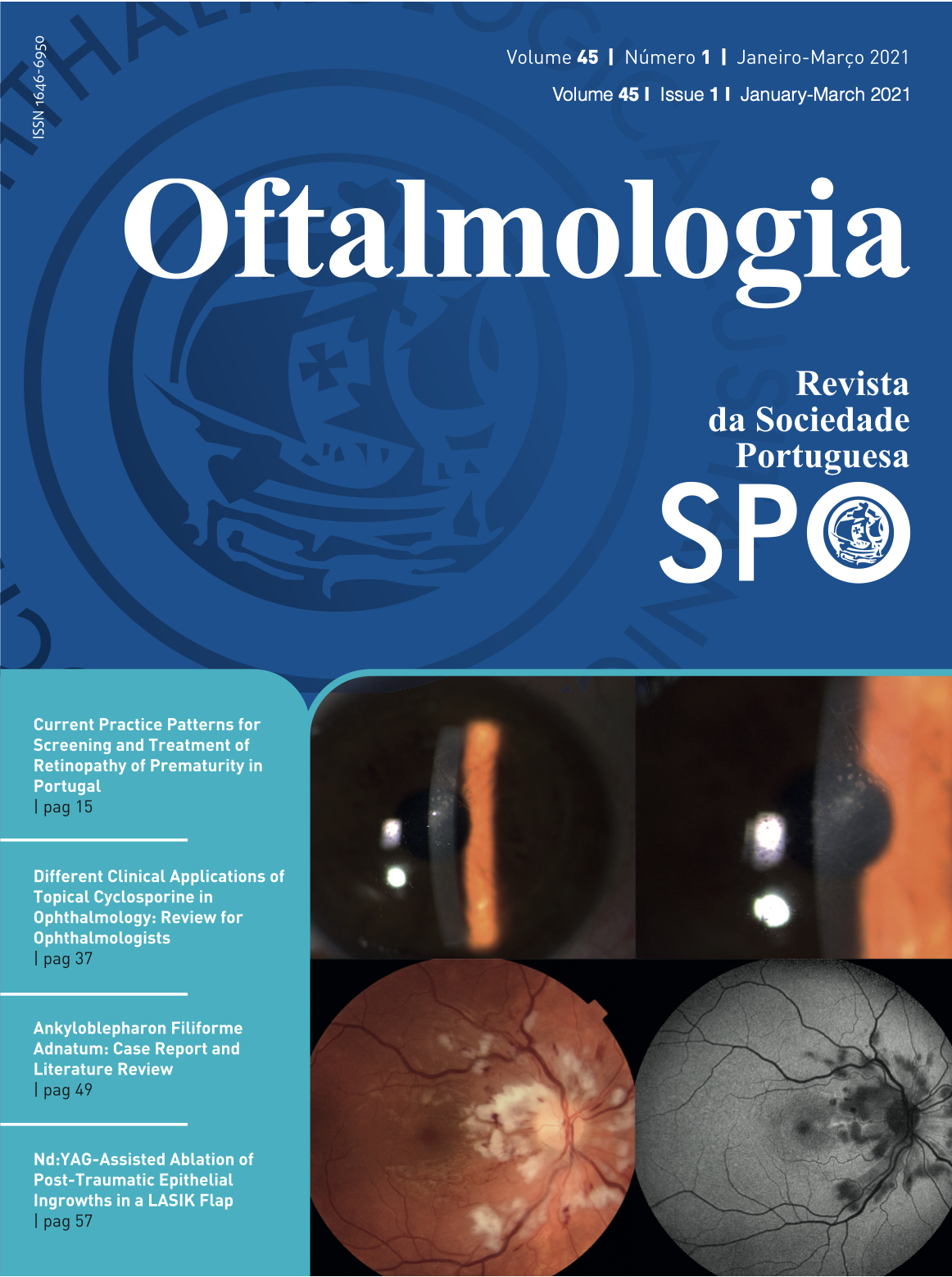Visual Stimulation Strategies in Cerebral Visual Impairment
DOI:
https://doi.org/10.48560/rspo.22183Keywords:
Mobile Applications, Photic Stimulation, Vision Disorders, Vision, LowAbstract
PURPOSE: To review visual stimulation (VS) strategies in patients with cerebral visual impairment (CVI) and to design a new VS application (app).
MATERIAL AND METHODS: 394 studies searched with terms “visual stimulation” and “cortical/cerebral visual impairment” were identified, through a search using the PubMed® database from inception to January 9, 2021. From those, 40 were selected. Regarding the development of the VS app, new strategies were applied in a mobile app that is named Steve. The platform was developed in Adobe Phonegap tool, using Javascript, HyperText Markup Language, and Cascading Style Sheets, being compatible with iOS and Android devices and also by other devices using a website. The app allows practicing with innovative animations and geometric shapes with different purposes. The system supports modifiable settings to change the size and velocity of content, to provide personalized learning.
RESULTS: Training with individual objectives, programs and methods of VS have to be adapted for each type of CVI. Stimulation with everyday objects, bright colors and high contrast patterns with smooth movement were the most effective strategies and were inserted into our suggestion of VS app.
CONCLUSION: Our proposal of VS app was created based on previously reported programs to stimulate the children more intensively in a familiar environment. We believe that this project could help the visual rehabilitation process in children, which requires persistence and other behavioral interventions.
Downloads
References
Lam FC, Lovett F, Dutton GN. Cerebral visual impairment in children: a longitudinal case study of functional outcomes beyond the visual acui-ties. J Vis Impair Blind. 2010;104:625–35. doi: 10.1177/0145482X1010401008.
Jan JE, Wong PK. The child with cortical visual impairment. Semin Ophthalmol. 1991;6:194–200. doi: 10.3109/08820539109060199.
Good W V, Jan JE, DeSa L, Barkovich AJ, Groenveld M. Cortical visual impairment in children. Surv Ophthalmol. 1994;38:351–64.
Huo R, Burden SK, Hoyt CS, Good W V. Chronic cortical visual impairment in children: aetiology, progno-sis, and associated neurological deficits. Br J Ophthal-mol. 1999;83:670–5.
Good W V, Jan JE, Burden SK, Skoczenski A, Candy R. Recent advances in cortical visual impairment. Dev Med Child Neurol. 2001;43:56–60. doi: 10.1017/s0012162201000093.
Chang MY, Borchert MS. Advances in the evaluation and management of cortical/cerebral visual impairment in children. Surv Ophthalmol. 2020;65:708-24. doi: 10.1016/j.survophthal.2020.03.001.
Ozen Tunay Z, Ustunyurt Z, Idil A. Causes of severe vi-sual impairment in infants and methods of management. Eye. 2020 (in press). doi: 10.1038/s41433-020-1101-z.
Sonksen PM, Petrie A, Drew KJ. Promotion of visual development of severely visually impaired babies: evaluation of a developmentally based programme. Dev Med Child Neurol. 1991;33:320–35. 9.Barraga N. Increased visual behavior in low vision children. New York: American Foundation for the Blind;1964.
Bell J. An approach to the stimulation of vision in the profoundly handicapped, visually handicapped child. Insight. 1986;4:46–8.
Hyvärinen L. Early stimulation of visually impaired infants. Ophthalmic Paediatr Genet. 1983;2:129–33.
Zeschitz M, Strothmann M. Visuelle Stimulation sehgeschädigter Kinder: Begleittext zur Diaserie. Würz-burg: Johann Wilhelm Klein-Akademie; 1990.
Zeschitz M. Früherkennung und Frühförderung mehrfachbehinderter, sehgeschädigter Kinder: mediative Frühförderung Würzburg. Frankfurt: Bock; 1985.
Fazzi E, Signorini SG, Bova SM, Ondei P, Bianchi PE. Early intervention in visually impaired children. In: International Congress Series. Amsterdam: Elsevier; 2005. p. 117–21. 15.
Lanners J, Piccioni A, Fea F, Goergen E. Early intervention for children with cerebral visual impairment: preliminary results. J Intellect Disabil Res. 1999;43:1–12. 16.Bourne JA, Morrone MC. Plasticity of visual pathways and function in the developing brain: Is the pulvinar a crucial player? Front Syst Neurosci. 2017;11:3. doi: 10.3389/fnsys.2017.00003.
Guzzetta A, Mercuri E, Cioni G. Visual disorders in children with brain lesions: 2. Visual impairment associated with cerebral palsy. Eur J Paediatr Neurol. 2001;5:115–9. doi: 10.1053/ejpn.2001.0481.
Newcomb S. The reliability of the CVI range: a functional vision assessment for children with cortical visual impairment. J Vis Impair Blind. 2010;104:637–47. doi: 10.1177/0145482X1010401009.
Hyvärinen L. Considerations in evaluation and treatment of the child with low vision. Am J Occup Ther. 1995;49:891–7.
Downloads
Published
How to Cite
Issue
Section
License
Do not forget to download the Authorship responsibility statement/Authorization for Publication and Conflict of Interest.
The article can only be submitted with these two documents.
To obtain the Authorship responsibility statement/Authorization for Publication file, click here.
To obtain the Conflict of Interest file (ICMJE template), click here







